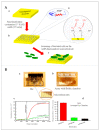Electrochemical Peptide-Based Sensors for Foodborne Pathogens Detection
- PMID: 34071841
- PMCID: PMC8198121
- DOI: 10.3390/molecules26113200
Electrochemical Peptide-Based Sensors for Foodborne Pathogens Detection
Abstract
Food safety and quality control pose serious issues to food industry and public health domains, in general, with direct effects on consumers. Any physical, chemical, or biological unexpected or unidentified food constituent may exhibit harmful effects on people and animals from mild to severe reactions. According to the World Health Organization (WHO), unsafe foodstuffs are especially dangerous for infants, young children, elderly, and chronic patients. It is imperative to continuously develop new technologies to detect foodborne pathogens and contaminants in order to aid the strengthening of healthcare and economic systems. In recent years, peptide-based sensors gained much attention in the field of food research as an alternative to immuno-, apta-, or DNA-based sensors. This review presents an overview of the electrochemical biosensors using peptides as molecular bio-recognition elements published mainly in the last decade, highlighting their possible application for rapid, non-destructive, and in situ analysis of food samples. Comparison with peptide-based optical and piezoelectrical sensors in terms of analytical performance is presented. Methods of foodstuffs pretreatment are also discussed.
Keywords: electrochemical sensors; food contamination; food safety; peptide; quality control.
Conflict of interest statement
The authors declare no conflict of interest.
Figures








Similar articles
-
Electrochemical biosensors for rapid detection of Escherichia coli O157:H7.Talanta. 2017 Jan 1;162:511-522. doi: 10.1016/j.talanta.2016.10.050. Epub 2016 Oct 12. Talanta. 2017. PMID: 27837864 Review.
-
Biosensors for rapid and sensitive detection of Staphylococcus aureus in food.Biosens Bioelectron. 2018 May 15;105:49-57. doi: 10.1016/j.bios.2018.01.023. Epub 2018 Jan 11. Biosens Bioelectron. 2018. PMID: 29358112 Review.
-
Biosensor for the detection of Listeria monocytogenes: emerging trends.Crit Rev Microbiol. 2018 Sep;44(5):590-608. doi: 10.1080/1040841X.2018.1473331. Epub 2018 May 23. Crit Rev Microbiol. 2018. PMID: 29790396 Review.
-
Electrochemical biosensors: The beacon for food safety and quality.Food Chem. 2025 May 30;475:143284. doi: 10.1016/j.foodchem.2025.143284. Epub 2025 Feb 9. Food Chem. 2025. PMID: 39956060 Review.
-
EIS-Based Biosensors in Foodborne Pathogen Detection with a Special Focus on Listeria monocytogenes.Methods Mol Biol. 2019;1918:87-101. doi: 10.1007/978-1-4939-9000-9_7. Methods Mol Biol. 2019. PMID: 30580401
Cited by
-
Development and Assessment of Regeneration Methods for Peptide-Based QCM Biosensors in VOCs Analysis Applications.Biosensors (Basel). 2022 May 7;12(5):309. doi: 10.3390/bios12050309. Biosensors (Basel). 2022. PMID: 35624609 Free PMC article.
-
A colorimetric sandwich assay based on magnetic separation of Brevinin-1BW-functionalized magnetic beads and porcine IgG for the detection of Staphylococcus aureus.Anal Bioanal Chem. 2025 Jun;417(15):3275-3284. doi: 10.1007/s00216-025-05862-8. Epub 2025 Apr 12. Anal Bioanal Chem. 2025. PMID: 40220072
-
Design and Construction of Enzyme-Based Electrochemical Gas Sensors.Molecules. 2023 Dec 19;29(1):5. doi: 10.3390/molecules29010005. Molecules. 2023. PMID: 38202588 Free PMC article. Review.
-
Electrochemical nanobiosensors equipped with peptides: a review.Mikrochim Acta. 2022 Feb 8;189(3):94. doi: 10.1007/s00604-022-05184-x. Mikrochim Acta. 2022. PMID: 35132460 Review.
-
Recent Advances on Peptide-Based Biosensors and Electronic Noses for Foodborne Pathogen Detection.Biosensors (Basel). 2023 Feb 11;13(2):258. doi: 10.3390/bios13020258. Biosensors (Basel). 2023. PMID: 36832024 Free PMC article. Review.
References
-
- Wilson D., Materón E.M., Ibáñez-Redín G., Faria R.C., Correa D.S., Oliveira O.N. Electrical detection of pathogenic bacteria in food samples using information visualization methods with a sensor based on magnetic nanoparticles functionalized with antimicrobial peptides. Talanta. 2019;194:611–618. doi: 10.1016/j.talanta.2018.10.089. - DOI - PubMed
-
- Li Y., Wang Z., Sun L., Liu L., Xu C., Kuang H. Nanoparticle-based sensors for food contaminants. TrAC Trends Anal. Chem. 2019;113:74–83. doi: 10.1016/j.trac.2019.01.012. - DOI
Publication types
MeSH terms
Substances
LinkOut - more resources
Full Text Sources
Medical

